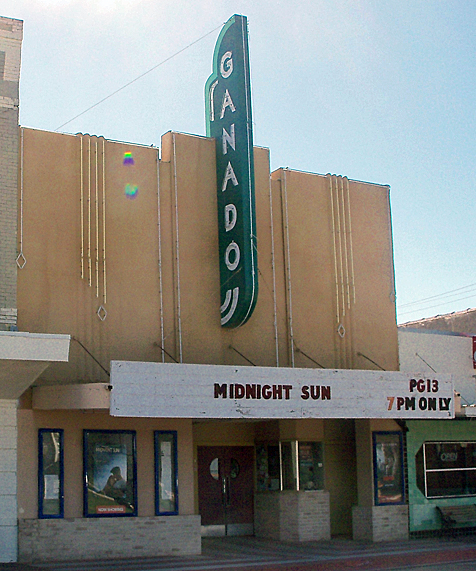|

|
|
Ganado
City Hall, 112 East Putnam Avenue, Ganado
|
|
|
Postmasters of
Ganado |
|
Brown,
Wilson M., 20 Feb 1883 |
|
McFarland, John, 17 Apr 1883 |
|
Babcock, Thos. W., 18 Jly 1884 |
|
Menefee,
Stephen A., 22 Sep 1885 |
|
Babcock, Thos. W., 29 Jly 1886 |
|
Rogers,
Frank W., 24 Dec 1887 |
|
Discontinued 8 Mar 1890; papers to Louise,
Wharton Co. |
|
Powlett,
John O., 12 Jun 1890 |
|
Heard,
Mary M., 19 Jan 1891 |
|
Rogers,
Sam'l. M., 26 May 1891 |
|
McGowan, Benj. F., 13 Feb 1892 |
|
McGowan, Jos. M., 20 Jun 1893 |
|
Hollingshead, Adolph N., 10 Jly 1897 |
|
Fields,
Welcome N., 7 Apr 1915 |
|
Silliman, Chas. W., 8 Nov 1922 (Acting
postmaster) |
|

1936 Map of Ganado from General
Highway Map of Jackson County, 1936
Ganado Independent School
District
Ganado News Articles
1900 - 1905
1932 - 1935
1936
Mauritz Memorial Jackson County Hospital
|

Texas Treasure
Business Awards
Ganado
American-Legion Post #346
Hillyard-Yoas Post #346
498 County
Road 256
|
|
|

|
Ganado
Established in 1882 as a shipping
point on New York, Texas & Mexican Railroad. Named
Ganado (Spanish for "herd") by railroad official.
Became a boomtown in 1891-92 when Scandinavian
immigrants settled area. Today a farm, oil and
shipping center.
Photo courtesy
of
G. W. Franzen |
|
|
|
GANADO, TEXAS. Ganado, on U. S Highway 59 nine miles east
of Edna, is the second largest town in Jackson County. Its
position on the Southern Pacific Railroad made it a shipping
and retail center for eastern Jackson County. An informal
cluster of cabins at the site was originally called Mustang
Settlement, after Mustang Creek. Early settlers, including
John Menefee and Jim McFarland, were chiefly cattle ranchers
who drove their herds to New Orleans over the Old Spanish
Trail or to northern markets in Kansas City. In 1881-82 the
Galveston, Harrisburg and San Antonio Railway was built
through the area near Mustang Settlement. Viewing a large
body of cattle from his rail car window, an official of the
company remarked that the place should be called
Ganado-Spanish for "herd." The name stuck; the railroad
erected the Ganado station later that year, and the town
grew up around it. A post office came the next year. Jim
McFarland moved his general store from its earlier location
on McFarland Creek to a site in town. After McFarland died,
Thomas Babcock-who was also the town's first
postmaster-bought the remaining stock and continued a store
in the building. Babcock's establishment, later known as the
Old Texas House, provided supplies to local ranchers. Soon
afterwards, Babcock also established the first residence and
first cotton gin in Ganado.
In
1891 a large number of northern Scandinavians purchased land
and began farming in the area. Although many of the old
settlers were initially wary of these outsiders, they came
to respect the Scandinavian colonists as a "hard-working,
industrious class of people." Ganado continued to flourish
with a number of German and Bohemian immigrants throughout
the 1880s and 1890s. Many became civic leaders. In 1891 T.
N. Mauritz opened the first bank in Ganado. By 1909 the town
had sixty businesses. The Ganado Independent School District
was formed in 1900, and by 1914 the 750 residents had added
a rice mill, a rice warehouse, another bank, and a weekly
newspaper named the Jackson County Independent. By
1950 the population had increased to 1,253. In 1988
forty-three businesses served 1,770 citizens. In 1990 the
population was 1,701.
History from the Handbook of Texas Online
|
|
City of Ganado



|
Greetings From Ganado Texas

|
Business Block, Ganado, Texas

|
Rice Elevator, Ganado, Texas

|
The Texas Company, Ganado, Texas

|
Spencer Home Near Ganado, Texas

|
|

|
|
116 South Third

|
|
KJT Hall

|
|
United States Post Office - Ganado, Texas
77962

|
|
Jackson County Hospital District Emergency
Medical Service

|
|

